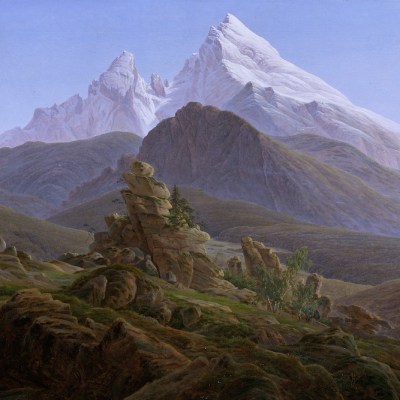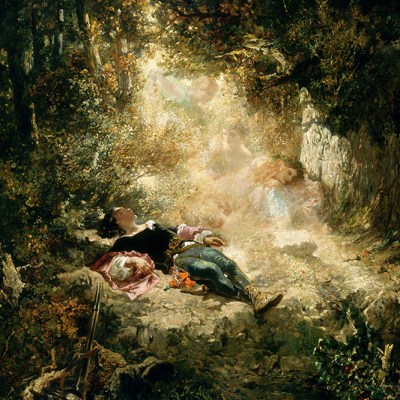Every revolution has its icons – images that bring the complex whirl of historical causality into focus. When it comes to representations of the Industrial Revolution, Joseph Mallord William Turner (1775–1851) was one of the first artists to capture the roar of the ‘dark satanic mills’. Through clouds of steam and smoke, his works on display in ‘A World of Care: Turner and the Environment’ at Turner’s House bear witness to the resulting ecological changes. It’s a tiny exhibition – the room can accommodate no more than five people at a time – but one that holds far-reaching implications.
Located in Twickenham, the house called Sandycombe Lodge was designed by Turner for his own use. The artist owned two acres of land in what today is a heavily gentrified area. It is the dialogue between past and present that this exhibition invites us to consider. Turner’s etching of Montenvers from 1817, showing where the Mer de Glace curves towards Chamonix at the foot of Mont Blanc, is displayed alongside a recent photograph by Chloe Dewe Mathews that shows the melting of the glacier and the ravages of global warming. The title of Mathews’ work, Mer de Glace (2016), from her series In Search of Frankenstein, is a reflection on Mary Shelley’s monster. She began writing her novel in 1816, during what came to be known as the ‘year without a summer’ on account of the eruption of Mount Tambora in Indonesia the previous April, which disrupted the world’s climate and obscured parts of the globe for more than a year; Turner and Shelley were among the painters and writers inspired by the event. To Mathews, ‘The grey bulk of melting glacier became, like Frankenstein’s creation, an embodiment of human folly.’
Mer de Glace (2016), Chloe Dewe Mathews. Photo: courtesy and © the artist
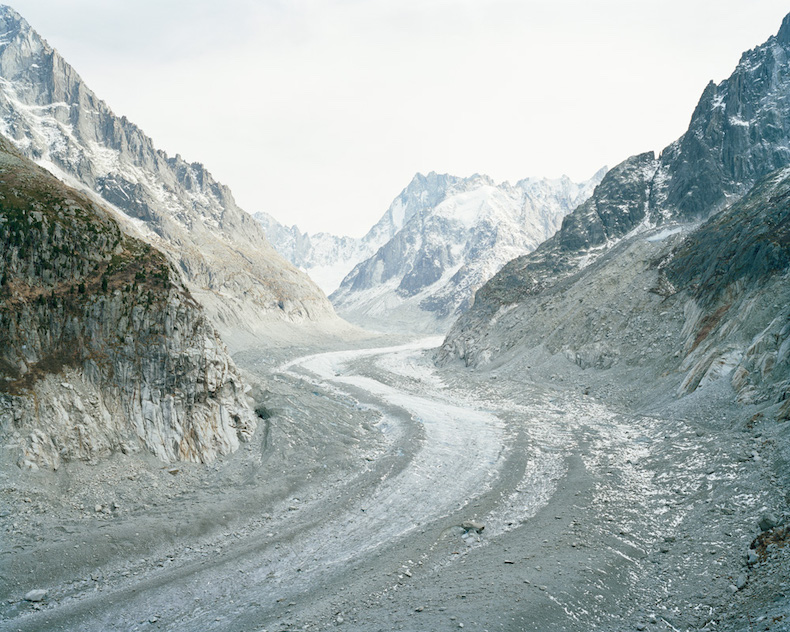
The show aims to inspire action, with works organised according to the various causes and effects of climate change: pollution, industrialisation, fossil fuels, transport, deforestation and natural disasters. Curator Thomas Ardill seizes the opportunity to re-read Turner’s disaster works, depictions of fires, floods or shipwrecks – once seen as ‘the consequences of sin and pride’ – to show how they now inevitably evoke the effects of human behaviour on the environment.
Even the lone oil painting, Sunset (1830–35), is mono-thematic: Turner’s only study entirely devoted to a sunset, and a fiery one at that. A wall label refers to the burning colours of the sky, situating the work in a global context by citing as a possible influence the level of ash dust in the air after what is widely believed to be the eruption in 1831 of the Babuyan Claro volcano in the Philippines (though it does not mention that there is some debate among volcanologists as to whether the volcano even erupted in the 19th century).
Sunset (1830–35), J.M.W. Turner. Photo: © Tate

The question of whether Turner was aware of environmental degradation has puzzled scholars. Throughout his oeuvre, steam serves as a symbol of both seductive progress and destructive modernity. It remains a challenge to determine Turner’s position and sympathies on the issues of his day. But the selection of works here suggests a range of anxieties. Rather than presuming to know Turner’s intentions, the exhibition encourages us to make Turner’s works our own, to read our world through his, and to see his landscapes less as nostalgic than as mutable.
In Crowhurst (1816), we’re confronted with the politics of wood: felled trees presage deforestation and eventually flooding. Whalers (c. 1859–61), engraved by R. Brandard after Turner’s Hurrah! for the Whaler Erebus! Another Fish! (c. 1846), might be said to hint at the problem of overfishing. Turner’s marine paintings of the 1840s chronicle a number of British commercial activities on the seas, including the slave trade.
Shields, on the River Tyne (1823), engraving by Charles Turner after J.M.W. Turner. Photo: © Tate
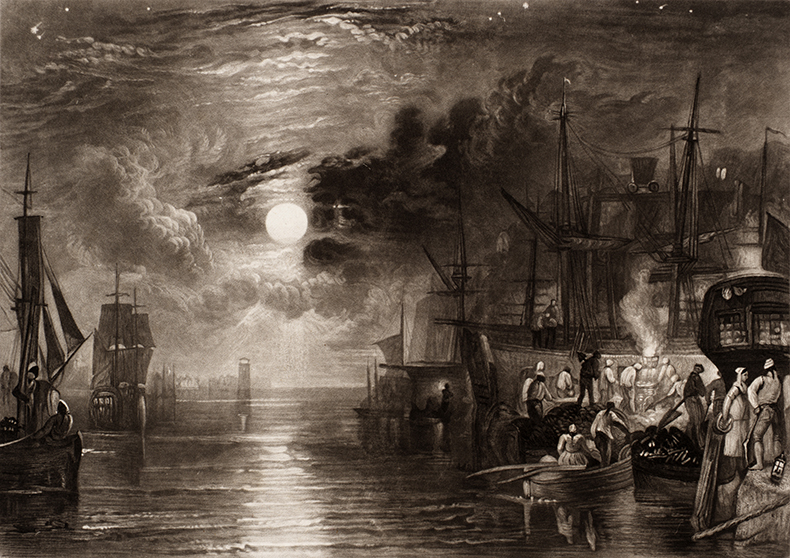
In London from Greenwich (c. 1808–09), executed in pencil and watercolour on paper as a study for a larger oil, we see the industrial city shrouded in plumes of smoke from steamships transporting sea-coal. Here, the multiplicity of funnels makes it difficult to distinguish one source of pollution from another. In Dudley, Worcestershire (1835), set in the Midlands – an area colloquially known at the time as the ‘Black Country’ – the faces and bodies of workers disappear, overwhelmed by the oppressive weight of industrial fumes. Turner immerses us in industrial capitalism’s exertion of control over both landscapes and workers’ bodies, as well as its toxic atmospheric by-products. Focusing on smell, the historian Alain Corbin has shown that even as social tolerance for foul odours diminished, pollution increased.
Fire at the Grand Storehouse of the Tower of London (1841), J.M.W. Turner. Photo: © Tate
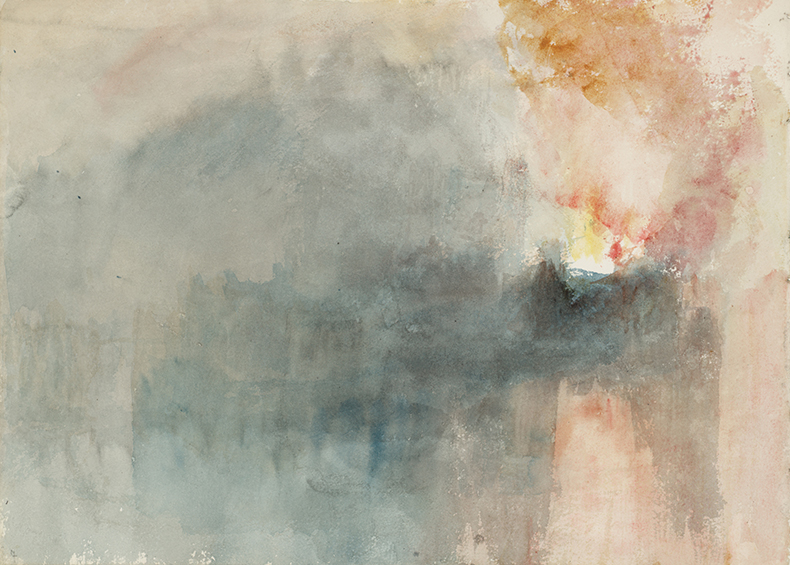
In lieu of a catalogue, an online ‘exhibition and climate action guide’ offers many recommendations and ideas for moving beyond passivity to address the problem of climate change. But perhaps the most encouraging outcome of this exhibition is the realisation that beauty needn’t distract us from concrete measures to improve our natural environment.
‘A World of Care: Turner and the Environment’ is at Turner’s House, London, until 27 October.

